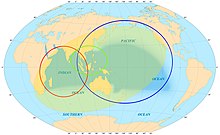Free and Open Indo-Pacific

Free and Open Indo-Pacific (FOIP; Japanese: 自由で開かれたインド太平洋戦略 jiyū de hirakareta Indotaiheiyō senryaku) is an umbrella term that encompasses Indo-Pacific specific strategies of countries with similar interests in the region.[1] The concept has been developed through Japanese and American cooperation.[2]
Japan introduced the FOIP concept and formally put it down as a strategy in 2016. In 2019 the United States Department of State published a document formalizing its concept of a free and open Indo-Pacific.[1][3]
History[]
The origin[]
Scholarship has shown that the geopolitical idea of the "Indo-Pacific" originated in Weimar Germany and spread to Japan through the translation of German geopolitical works, especially those of Karl Haushofer. Harvard academic Hansong Li shows in the Modern Intellectual History that Haushofer, who visited Japan as a military observer, aimed to build an "Indo-Pacific" comprising anticolonial powers to rebalance British, American, and Western European domination.[4] In The Paper and the Zhejiang Academic Journal, Li argues that Haushofer's geopolitical thought survived in post-war Japan to the present day.[5][6]
According to of Toyo University, FOIP, draws from the "Arc of Freedom and Prosperity" idea which Japan advanced in 2006–07. According to the Japanese Ministry of Foreign Affairs, Prime Minister Shinzo Abe first explained Japan's commitment to the FOIP strategy in Kenya on 27 August 2016.[2][7] However even before this the concept of FOIP also falls in place with Abe's thinking of "diplomacy that takes a panoramic perspective of the world map". In 2012, Prime Minister Abe's first elucidation of FOIP went as follows:[2][8]
Peace, stability, and freedom of navigation in the Pacific Ocean are inseparable from peace, stability, and freedom of navigation in the Indian Ocean. Japan, as one of the oldest sea-faring democracies in Asia, should play a greater role—alongside Australia, India, and the US—in preserving the common good in both regions
Japan's diplomatic implementation[]
In January 2013, Japanese government had prepared a PM Abe's speech on "Five New Principles" to be delivered in Jakarta. However, as PM Abe had to go back to Japan before the scheduled date to respond to In Amenas hostage crisis, the speech was not realized, instead its script was made available.[9]
In 2015, to implement the framework, Japan upgraded "The Guidelines for Japan-U.S. Defense Cooperation" with US,[10] agreed and shared "Japan and India Vision 2025 Special Strategic and Global Partnership" with India,[11] agreed and shared "Next steps of the Special Strategic Partnership: Asia, Pacific and Beyond" with Australia,[12] and the quadrilateral framework was prepared.
In US National Security Strategy[]
Subsequently, in the 2017 US National Security Strategy, Asia-Pacific was exchanged with Indo-Pacific.[2]
In South Korean diplomatic strategy[]
South Korea's approach to the Indo-Pacific is based on cooperation and complementarity between its New Southern Policy and the U.S.'s and the Quad's Indo-Pacific policy, but without openly antagonizing China.[13]In this respect, South Korea is balancing the desire for foreign policy autonomy with the need for strategic alliances, above all the United States.[14]
See also[]
References[]
- ^ Jump up to: a b Hosoya, Nicholas Szechenyi, Yuichi; Hosoya, Nicholas Szechenyi, Yuichi (10 October 2020). "Working Toward a Free and Open Indo-Pacific". Carnegie Endowment for International Peace. Archived from the original on 2020-10-29. Retrieved 2020-11-04.
- ^ Jump up to: a b c d Watanabe, Tsuneo "Nabe" (30 October 2019). "Japan's Rationale for the Free and Open Indo-Pacific Strategy [1]". International Information Network Analysis | The Sasakawa Peace Foundation. Archived from the original on 2020-10-27. Retrieved 2020-11-04.
- ^ "A Free and Open Indo-Pacific: Advancing a Shared Vision" (PDF). www.state.gov. U.S. State Department. 4 November 2019. Archived (PDF) from the original on 28 October 2020.
- ^ Li, Hansong (2021-06-04). "The "Indo-Pacific": Intellectual Origins and International Visions in Global Contexts". Modern Intellectual History: 1–27. doi:10.1017/S1479244321000214. Retrieved 22 June 2021.
- ^ Li, Hansong (2021). ""印太"概念:全球语境中的思想溯源和国际接收". 浙江学刊 (2): 61–72. Retrieved 22 June 2021.
- ^ Li, Hansong (27 December 2020). "重思"印太"概念的前世今生_私家历史_澎湃新闻-The Paper". www.thepaper.cn. The Paper. Retrieved 22 June 2021.
- ^ "Address by Prime Minister Shinzo Abe at the Opening Session of TICAD VI". Ministry of Foreign Affairs of Japan. 27 August 2016. Archived from the original on 2020-11-07. Retrieved 2020-11-04.
- ^ Abe, Shinzo (2012-12-27). "Asia's Democratic Security Diamond | by Shinzo Abe". Project Syndicate. Archived from the original on 2021-01-18. Retrieved 2020-11-04.
- ^ Shinzo Abe (18 January 2013). "The Bounty of the Open Seas: Five New Principles for Japanese Diplomacy". MOFA, Japan. Retrieved 15 February 2021.
- ^ "The Guidelines for Japan-U.S. Defense Cooperation" (PDF). MOFA, Japan. 27 April 2015. Retrieved 16 February 2021.
- ^ "Japan and India Vision 2025 Special Strategic and Global Partnership". MOFA, Japan. 12 December 2015. Retrieved 16 February 2021.
- ^ "Next steps of the Special Strategic Partnership: Asia, Pacific and Beyond". MOFA, Japan. 18 December 2015. Retrieved 16 February 2021.
- ^ Pacheco Pardo, Ramon (May 2021). "South Korea Rebuffed Trump. Here's Why It Might Cooperate with Biden".
- ^ Snyder, Scott A. (March 2020). "South Korea at the Crossroads: Autonomy and Alliance in an Era of Rival Powers".
External links[]
- "Foreign Policy / Free and Open Indo-Pacific". MOFA, Japan. 1 February 2021.
- "Free and Open Indo-Pacific" (PDF). MOFA, Japan. February 1, 2021.
- MOFA, Japan. "(Video) Japan's Efforts toward Free and Open Indo-PacificOpen a new window". YouTube.
- MOFA, Japan. "(Video) Japan's Connectivity Support for a Free and Open Indo-PacificOpen a new window". YouTube.
- MOFA, Japan. "(Video) Japan Shares Solutions: Maritime SecurityOpen a new window". YouTube.
- MOFA, Japan. "(Video) The Rule of Law at Sea". YouTube.
- Valencia, Mark J. (30 March 2020). "What Does a 'Free and Open Indo-Pacific' Actually Mean?". thediplomat.com. Archived from the original on 2020-11-05. Retrieved 2020-11-04.
- Indian Ocean
- Pacific Ocean
- Free trade agreements of Japan
- Free trade agreements of the United States
- Foreign relations stubs